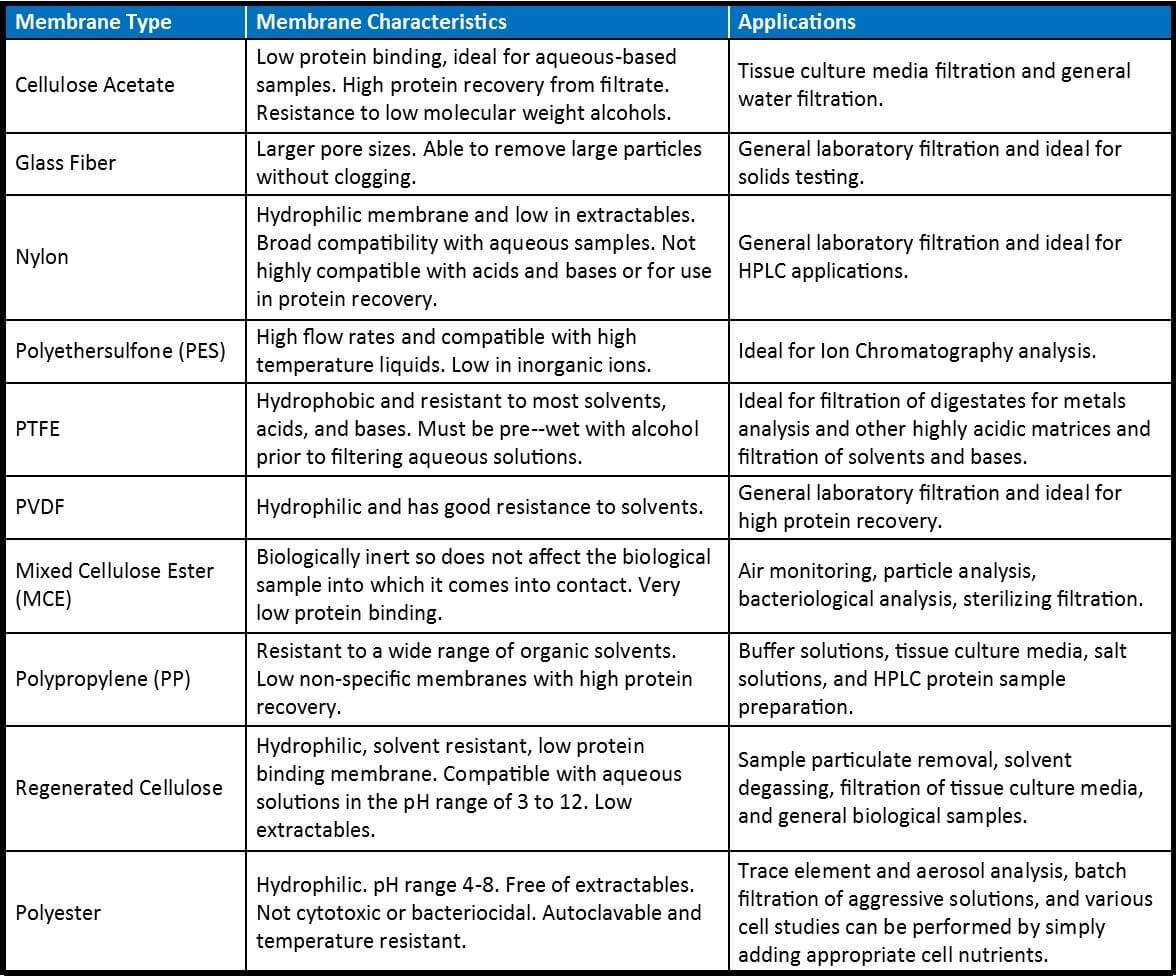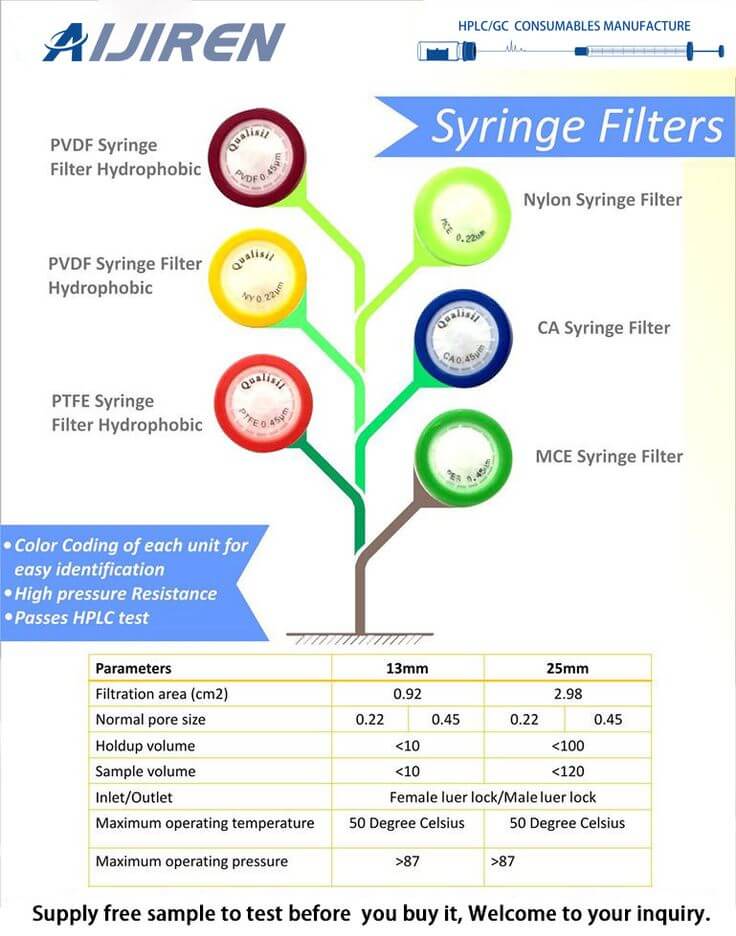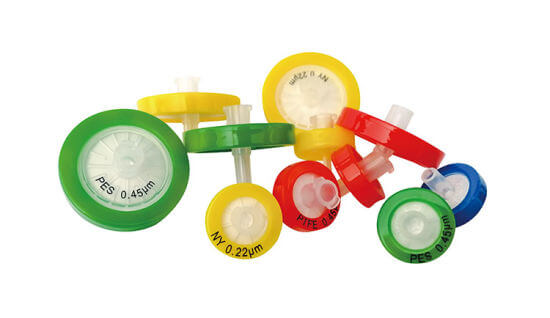How do I Choose a Membrane Syringe Filter?
Choose economical HPLC syringe filters to remove particulates from your liquid samples prior to injection on your HPLC. Our syringe filters are economical and designed to be single-use for your convenience and for laboratory efficiency. Determining the Perfect Syringe Filter in 4 Simple Steps.

Step 1: Selection of the Membrane by Application
In the table below you can find the most popular applications where scientists are using Aijiren Syringe Filters in their laboratories. The table below presents recommended membranes and alternative membranes for each application type. Finally, your choice of the membrane can be validated by reviewing the description of each membrane in the Aijiren portfolio.
|
Membrane Selection by Application |
||
| Applications | Recommended Membranes | Alternative Membranes |
| Sample preparation prior to HPLC & GC analysis | Nylon | PTFE, PES or RC |
| Protein analysis or biological solutions | PVDF or PES | Nylon or RC |
| High particulate loads | Nylon | RC or PTFE |
| Pure organic and aggressive solvents | PTFE | RC or Nylon |
| Environmental analysis | PTFE or Nylon | RC |
| Clinical or toxicological analysis | PES | RC |
| Food & beverage analysis | PTFE or Nylon | RC |
| Sample preparation prior to ionic chromatography analysis | PES | PTFE or RC |
| Capillary electrophoresis analysis | PES | RC |
| Sample preparation prior to ICP-MS or AAS analysis (trace metals) | PES or Nylon | RC |
Membrane Descriptions
Nylon: Hydrophilic membrane is working well for general filtrations, aqueous & mixed organic solutions, medical assays, and HPLC sample preparations.
Polytetrafluoroethylene (PTFE): Hydrophobic polytetrafluoroethylene membrane is an excellent media for the filtration of strong acids and aggressive organic solvents. Wetting the membrane with alcohol and water gives a hydrophilic characteristic.
Polyvinylidene Fluoride (PVDF): Hydrophilic polyvinylidene fluoride membrane presents low extractability and provides good filtration of aqueous solutions, organic solvents, and biological solutions.
Polyethersulfone (PES): Hydrophilic polyethersulfone membrane is mainly used for life-science applications (biological & pharmaceutical) because of the ultra-low protein binding characteristic of the membrane.
Regenerated Cellulose (RC): Regenerated cellulose is a universal hydrophilic membrane used in chromatography for the filtration of aqueous samples and solvents. This membrane is also used for filtration of biomolecules because of the ultra-low binding capability of the media.

Step 2: Selection of the Membrane Porosity Based on the Sample Nature
The most commonly used syringe filter pore sizes are 0.2/0.22μm and 0.45μm syringe filters, for research and medical applications.
1. The pore size to be used is usually determined by the particle size to be eliminated. For example, for the purpose of filtering out particulate >0.2 microns in diameter, then choose a syringe filter with 0.2-micron pore size.
2. Another way to determine the micron size of columns, is 0.45μm for >3μm, and 0.22μm for <μm.
3.0.45μm membranes are typically used for general filtration and particle removal while 0.2/0.22μm membranes, or sterilizing-grade membranes, are most commonly used for solution sterilization (bacteria removal).
Step 3: Selection of the Membrane Diameter Based on Sample Volume


All filter inlets are female Luer-Lock compatible, have inert polypropylene housings, and come in three diameters. The diameter is determined by the volume to be filtered.
13 mm Syringe Filters
For sample volumes <10 mL range;
An ideal choice for most applications;
Holdup (dead) volume is <15 ul.
Female inlet Luer lock
Maximum operation pressure <15 bar
Bubble point: Hydrophilic 2-3 bar; Hydrophobic 1-1.2 bar
25 mm Syringe Filters
For sample volumes <100 mL range;
Holdup (dead) volume is <125 ul.
Female inlet Luer lock
Maximum operation pressure <10 bar
Bubble point: Hydrophilic 2-3 bar; Hydrophobic 1-1.2 bar
33 mm filters
For sample volumes <250 mL range;
Holdup (dead) volume is <180 ul.
Female inlet Luer lock
33mm filters are ideal for high throughput labs
Step 4: Selection of the sterile or non-sterile
As we use syringe filters to eliminate unwanted particles from a solution, we can either choose sterile or non-sterile (much cheaper option), depending on the processing applications:
If a sterilized solution is needed, sterile syringe filters come individually wrapped to ensure optimal performance without contamination.
If your solution is going to be filtered through a sterilization process, then a non-sterile syringe filter should meet your requirements.
Summary
Please contact Aijiren at www.hplcvials.com to help you select the correct syringe filter membrane for your application. Aijiren syringe filters are color-coded based on the filter membrane; therefore, if you keep multiple types of syringe filters in the lab, you can easily tell you have the correct membrane for your method. Aijiren syringe filters are a common chromatography consumable to have in the lab for analytical testing. Using syringe filters can protect your HPLC instrumentation from harmful particulates and help you maximize your instruments’ uptime.
Back to List
-
 下午4:09Weighing the Pros and Cons of PTFE/Silicone Septa
下午4:09Weighing the Pros and Cons of PTFE/Silicone Septa -
 下午4:05Decoding Vial Discard Guidelines: Ensuring Precision in Chromatography
下午4:05Decoding Vial Discard Guidelines: Ensuring Precision in Chromatography -
 下午5:01Navigating Micro Inserts for HPLC Vials: A Comprehensive Guide
下午5:01Navigating Micro Inserts for HPLC Vials: A Comprehensive Guide -
.jpg) 下午2:02Common faults and solutions of automatic samplers(2)
下午2:02Common faults and solutions of automatic samplers(2) -
 下午5:08Ensuring Sample Integrity: Navigating EPA Storage Vials Stability Guidelines
下午5:08Ensuring Sample Integrity: Navigating EPA Storage Vials Stability Guidelines

